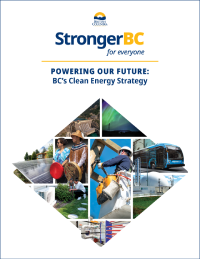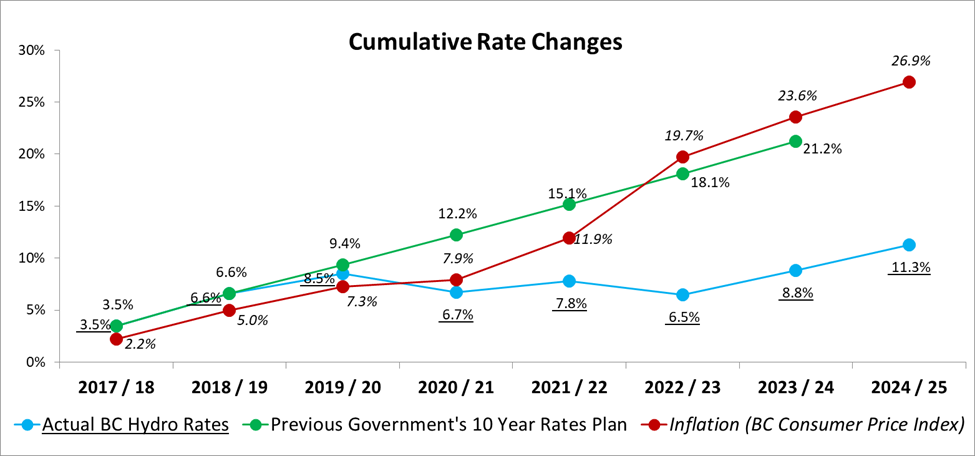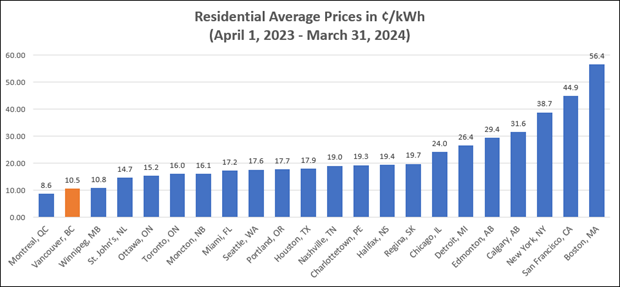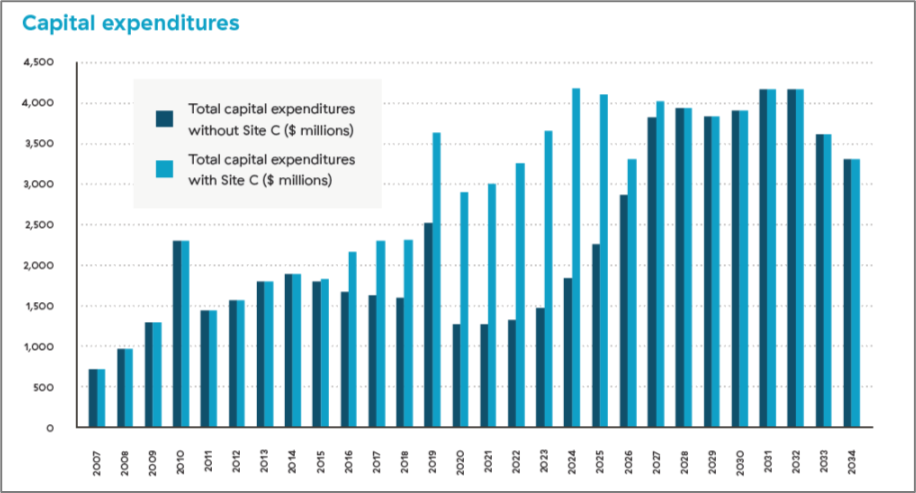Powering Our Future: BC's Clean Energy Strategy
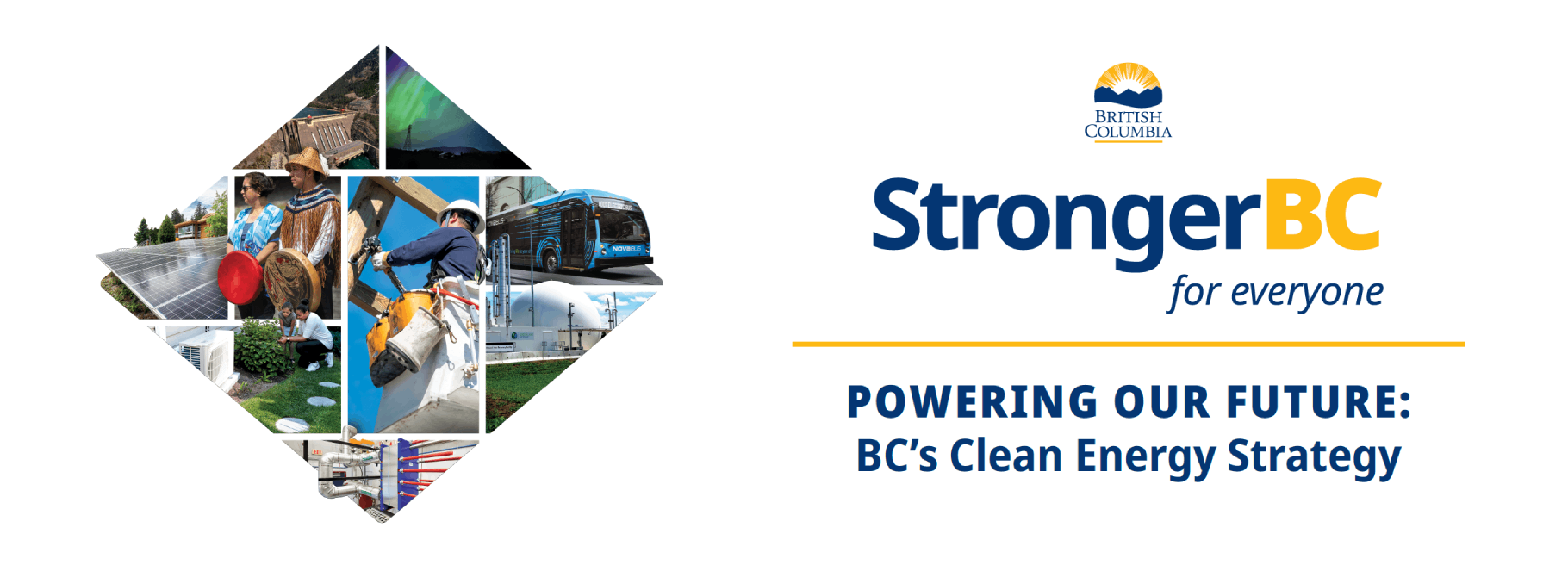
Table of contents
- Land acknowledgement
- Message from the Minister
- Introduction
- Vision and principles
- Areas of focus
- Using energy more efficiently
- Keeping rates affordable for people and businesses
- Increasing and diversifying our production of clean electricity
- Maximizing our production of clean fuels
- Building out BC’s electricity grid and connecting customers faster
- Expanding opportunities for Indigenous Peoples
- Planning for a resilient future
- Creating jobs and supporting sustainable growth
- Driving innovation and clean energy technology
- Trading with our neighbours to benefit BC
- Conclusion
Land acknowledgement
We acknowledge with respect and gratitude that this report was produced on the territories of First Nations around BC and the Government of British Columbia is grateful to carry out our work on these lands.

Message from the Minister
Energy powers the economy. Each of us relies on it every day – to heat our homes, to move our vehicles, and to run businesses and industries.
Energy is also at the root of the climate crisis. Burning fossil fuels is changing our climate – creating more extreme weather, bigger forest fires, deeper droughts and more frequent flooding throughout BC.
Climate change has created an urgent need to move away from reliance on fossil fuels and make the switch to powering our economy with clean energy. That’s why we have committed to building a net zero economy by 2050.
While BC has a head start – with a heritage hydro-electric system that is almost entirely powered by clean and renewable energy sources – the vast majority of energy powering BC today still comes from fossil fuels.
Replacing fossil fuels with a mix of clean and low-carbon energy sources will require a massive expansion of clean energy infrastructure. It could require a doubling of the province’s capacity to generate electricity by 2050, even with increased investments to waste less energy and improve the efficiency of our homes and buildings.
It will also require building up BC’s capacity to produce clean fuels like renewable natural gas, hydrogen, and biofuels. That’s why we’re working to produce at least 1.5 billion litres per year of renewable fuels by 2030 as we work toward our net zero goals in 2050.
We must upgrade our energy transmission and distribution systems to not only accommodate new sources of energy, but also to withstand greater extremes in weather and temperature and become more resilient and reliable for people and communities. That’s why BC Hydro’s $36 billion ten-year capital plan is so critical to BC’s future – it is the backbone of the province’s efforts to build a clean economy.
The scale and scope of the work that is needed to power our future will require a whole-of-BC effort that will create jobs, spark new industries, and drive innovation for decades to come, in every part of the province.
Building an economy powered by clean energy is one of the job-creation opportunities of our generation. It will drive economic growth as we work together to fight climate change and make our energy system more resilient, reliable and secure for today and generations to come.
People throughout the province are doing their part – by making the switch at record numbers to powering their homes, their vehicles and their businesses with clean electricity.
This document outlines what government is doing to power our future with clean energy while maintaining affordable electricity rates for people and businesses, addressing energy poverty, and continuing to advance reconciliation with First Nations.
Thank you to the many individuals, Indigenous governing bodies and organizations, businesses, interest groups, and others that have contributed to this document through roundtables and other engagement forums over the past year.
I look forward to continuing this dialogue with people all over the province to achieve our vision for a clean, competitive and inclusive British Columbia that is powered by made-in-BC clean energy and achieves net zero emissions by 2050.
Josie Osborne, Minister of Energy, Mines and Low Carbon Innovation
Introduction
Powering Our Future: BC’s Clean Energy Strategy outlines the actions that we are – and will be – taking in ten areas of focus to accelerate the shift to clean energy and create new opportunities for people and communities throughout BC. It builds on and complements work that’s being done across government to create jobs, open up opportunities, and support the growth of key industries throughout BC while tackling climate change, including through CleanBC, the FutureReady Action Plan, and Clean and Competitive: A Blueprint for BC’s Industrial Future.
BC is already a clean energy superpower. But to build a clean economy and support growing communities, we need to produce even more clean electricity in the years and decades to come. That means building out the electricity grid and issuing regular, competitive calls for power to increase and diversify BC’s electricity production, creating thousands of good jobs.
While a net zero future means increasing amounts of electrification, there are many parts of the economy that cannot easily be powered by electricity. That’s why we need to ramp up BC’s production of clean fuels in emerging industries like hydrogen, renewable natural gas and biofuels.
Efficiency is, however, often our best energy resource. By investing in energy efficiency, we can waste less energy, save people and businesses on their energy bills, and reduce harmful pollution. We need to make sure that cleaner and more energy efficient options – like heat pumps – are available, affordable and accessible for people and businesses. And we need to provide support for those who need it most, ensuring that no one is left behind in the transition to clean energy.
We need to make sure that clean energy remains affordable for households that are struggling with high interest rates and global inflation. Keeping the cost of electricity low will also maintain BC’s competitive advantage in attracting investment from traditional and new industries wanting to power their operations with clean energy.
A focus on people and communities also means recognizing regional differences. What makes sense for people and businesses in Vancouver or Victoria may not in 100 Mile House, Prince George or other colder climates, let alone for remote communities not connected to the electricity grid.
Building an economy powered by clean energy will create new opportunities for people and communities across the province, including for First Nations that are already leaders in the clean energy sector. By supporting meaningful partnerships and expanding opportunities for Indigenous Peoples, we can achieve our clean energy goals while advancing reconciliation.
Vision and principles
Vision statement
A clean, competitive and inclusive British Columbia that is powered by made-in-BC clean energy and achieves net zero emissions by 2050.
Overarching principle
Advance reconciliation with Indigenous Peoples
Guiding principles
- Put energy efficiency first
- Reduce emissions and support climate action
- Embrace innovation and new technology
- Ensure safety and reliability
- Protect energy affordability and reduce energy poverty
- Promote sustainable economic growth
- Recognize regional differences across BC
- Build healthy and resilient communities
Areas of focus
Using energy more efficiently
Both BC Hydro and FortisBC are making record investments in energy efficiency programs:
- BC Hydro’s updated Energy Efficiency Plan includes over $700 million in three years – an increase of 60% from the previous budget – and is estimated to save its customers about $80 million per year starting in 2026
- FortisBC will invest $695 million over four years to help its customers use less energy while reducing carbon emissions by 740,000 tonnes
Energy efficiency can be the best and most cost-effective way for BC to meet future energy demand – while also lowering energy bills for people and businesses. By helping people use less energy, we can better manage the energy system and avoid unnecessary and expensive infrastructure upgrades. When investments in energy efficiency – often referred to as “demand-side management” – also reduce the use of fossil fuels, they can also be one of the easiest ways to lower emissions and meet our climate goals. That’s why Powering Our Future is committed to an “efficiency first” approach.
From better insulation and energy-saving windows to LED lightbulbs and high-efficiency heat pumps, energy efficiency technology continues to improve and become more affordable year after year. In fact, improvements in energy efficiency are a large part of the reason why electricity demand in BC has stayed relatively flat over the past couple decades, despite increases in population and a growing economy. British Columbians have achieved over 7,000 gigawatt hours (GWh) per year in energy savings through BC Hydro’s energy efficiency programs. That’s equivalent to the energy consumption of over 700,000 homes and about 35% more energy than what Site C will generate.
Helping families save money with energy saving retrofits
Households that switch from fossil fuel heating to electric heat pumps can see energy savings of as much as 80%. Heat pumps also keep homes comfortable year-round, doubling as air conditioners that provide efficient cooling in summer, in addition to keeping people warm in winter.
Heat pumps are a smart choice, which is why Government recently launched the CleanBC Better Homes Energy Savings Program in partnership with the federal government and BC Hydro. This program offers enhanced supports to people to make fuel-switching and energy-saving upgrades more affordable – including heat pumps – for low- and middle- income households.
With increased rebate amounts of up to $24,000, income-qualified households may be eligible to receive a free heat pump, making a real difference in these families’ lives and helping to alleviate energy poverty. Significant improvements over past rebate programs include a more streamlined online application process, households no longer having to pay upfront, and consolidated federal and provincial rebates. Now, households only pay the remaining cost after all rebates, whether provincial or federal, are deducted right off the contractor’s invoice.
Government will continue to explore and find ways to make federal, provincial, municipal, and utility efficiency programs more coordinated, integrated, and accessible for British Columbians – while also creating good, well-paying jobs for workers as we build a clean economy. Other provinces, for example, have dedicated organizations responsible for coordinating energy efficiency programming.
Highest efficiency equipment standards
British Columbians continue to make the shift to heat pumps in record numbers. In 2022, the number of households in BC with heat pumps had increased by approximately 80% since 2017, from an estimated 142,000 to 254,000. And in 2022 and 2023, for the first time ever, BC heating equipment distributors imported more residential heat pumps than natural gas furnaces.
Because energy efficiency is one of the best ways to reduce costs and emissions in homes, Government regularly updates equipment standards to ensure household appliances sold to British Columbians meet industry-leading efficiency levels. This helps ensure energy savings and avoid costly replacements of appliances within just a few years time.
Government recently completed engagements on proposed Highest Efficiency Equipment Standards for space and water heating, which would require all new space and water heating equipment sold and installed in BC starting in 2030 to be at least 100% efficient – meaning an electric heat pump, gas heat pump, or dual-fuel system (where an electric heat pump is paired with a conventional natural gas furnace, for example). Households that currently use gas- and oil-fired heating equipment would be able to continue to use and repair them until their end-of-life, when they can be replaced with a 100% efficient (or better) system. The proposed standard would not cover fireplaces, stoves and other cooking equipment.
Figure 1: BC shipment data – Residential forced air heating equipment
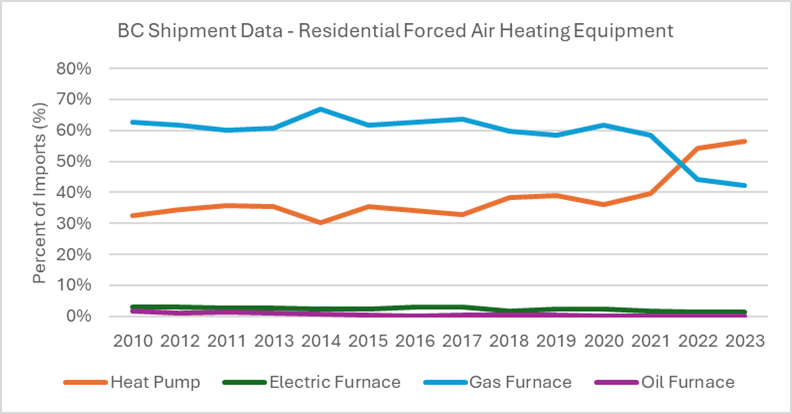
Source: Graph created based on industry-provided data
Energy efficient homes and buildings
BC first introduced energy efficiency as a BC Building Code objective in 2008. Ever since, designers and builders have had the option to use either “prescriptive” or “performance” approaches to comply with the code’s efficiency requirements.
For local governments, the BC Energy Step Code offers assurance that new homes and buildings are performing as billed and provides builders with flexibility on how they meet the energy efficiency requirements – by incorporating innovative solutions, new techniques, and leading-edge technologies. In May 2023, the BC Building Code began requiring most new buildings to meet 20%-better energy efficiency. Local governments may still incentivize or require builders to achieve higher steps of the code.
The Zero Carbon Step Code is a new tool to help BC meet its climate change objectives and reduce emissions from space and water heating. Local governments can choose which levels to apply to new homes and buildings (Part 3 and Part 9), and under what conditions or circumstances. The Code includes multiple compliance pathways, meaning that natural gas can still be used for cooking – such as cooktops, woodstoves and barbecues – even at the highest performance level. The Zero Carbon Step Code also does not apply to individual restaurants.
Keeping rates affordable for people and businesses
We’re keeping rate increases well below the rate of inflation – almost 16% lower since 2017/18 – to help keep life affordable.
With global inflation causing the cost of so many goods to rise, it’s more important than ever to keep the cost of clean electricity as affordable as possible. Between 2000/01 and 2016/17, BC Hydro rates increased by a total of 80%, or 5% per year on average. Since then, Government passed new legislation to return oversight for setting electricity rates to the independent BC Utilities Commission (BCUC) and has kept rate changes below inflation for six consecutive years.
In addition to keeping rates low, BC Hydro has also provided on-bill credits for families and businesses that are struggling with the cost of living. Under the BC Electricity Affordability Credit included in Budget 2024, average residential customers will see savings of $100 this year and commercial customers will save around $400 to help with rising costs.
Keeping the cost of electricity as low as possible is not only important for making life more affordable for people and businesses but is also critical to maintaining BC’s competitive advantage in attracting new investment from industries wanting to keep their power costs down. This helps to grow BC’s clean economy and create new, good jobs for workers. And when electricity costs less than fossil fuels, it supports existing industries in retrofitting their operations to make the switch to clean energy, reduce harmful pollution, and build healthier communities.
Prioritizing affordability in the long-term
Looking to the future, Government recently updated BC’s Energy Objectives under the Clean Energy Act to help ensure that people and businesses continue to have access to the affordable, clean electricity needed to power our growing economy.
The Clean Energy Act includes a list of BC’s energy objectives that the BCUC is required to consider in making its decisions on BC Hydro’s rate applications. In February 2024, Government added new objectives – including that BC Hydro rates do not exceed the cumulative rate of inflation and that rate changes are predictable and stable from year to year. This is the first time in the history of the Act that affordability and stability in rates are a clear goal in BCUC decision-making as BC increases power production and expands the electricity grid.
Figure 3: Comparison of BC Hydro’s residential electricity rates to other jurisdictions (example cities)
Source: Electricity rates are based on average prices from surveys conducted by Hydro-Quebec for 21 North American utilities, published annually in the Hydro-Quebec’s Comparison of electricity prices report.
BC Hydro currently has the second-lowest residential electricity rates in North America, and the third lowest commercial and industrial rates.
More choices, more savings
More and more, people are looking for choices in electricity price plans, so they can choose the plan that works best for their lifestyle and keeps their energy bills as low as possible. BC Hydro’s new, voluntary Time-of-Day rate does just that – offering residential customers lower rates if they shift their electricity use to periods when demand for electricity is lower and there is more system capacity. Customers who voluntarily choose the Time-of-Day rate can save money by shifting their energy-intensive activities to off-peak hours – for example, by delaying when they set their laundry or dishwasher to run, or by plugging in an electric vehicle to charge overnight.
Voluntary rate options provide savings for customers, but they also benefit everyone because they reduce BC Hydro’s overall costs of managing peak energy demand during the day. And by avoiding unnecessary and costly infrastructure upgrades, this will also keep rates low for all BC Hydro customers.
Moving forward, BC Hydro intends to continue engaging with its customers to develop other voluntary rate options – such as an optional flat rate – so that people can choose how they pay for electricity to meet their needs while saving the most on their energy bills. By offering customers a single charge for electricity (in between the current Step 1 and Step 2 rates), this could also provide households with greater certainty on their energy bills as they decide to get off fossil fuels and use more clean electricity at home, such as by installing a heat pump or charging their electric vehicle.
Our energy wallet: A holistic way of viewing how we use and pay for all the energy services we need
BC has a diversity of clean energy resources that power different parts of our society and economy. This diversity is one of BC’s strengths, and it’s an important factor for planning our province-wide energy system. Similarly, on an individual or household level, we use a number of different energy sources to power different things in our homes and lives – from cars to home heating to kitchen appliances.
The concept of an “energy wallet” shifts our focus from the individual energy bills we pay on a daily or monthly basis (like gasoline, natural gas, and electricity) and looks instead at our energy use as a bundle of services used over time – considering not just current energy costs to operate the devices and appliances we rely on but also how these costs may change over time, as well as the cost to buy, maintain and replace them.
For example, an electric vehicle may cost more up front than one fueled with gasoline, but it is less costly to maintain and operate over the long term. Similarly it can be difficult for families to afford the up front cost of switching to more energy efficient heating for their home, like a heat pump, even though they would save more than it costs over the long term. That’s why Government is working to help British Columbians with the higher upfront costs that often come with switching to cleaner or more efficient energy options.
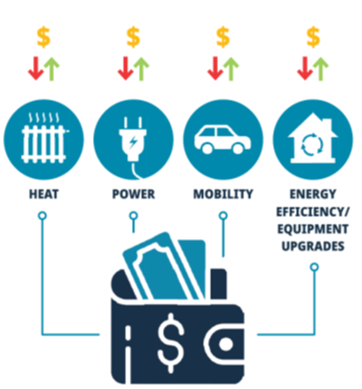
Increasing and diversifying our production of clean energy
With 98% of BC’s electricity already coming from clean or renewable sources, our efforts are focused on increasing and diversifying the production of clean electricity, unlike many other jurisdictions that are still reliant on coal and natural gas for power production. As a start, the Site C dam is scheduled to be fully in service in 2025, adding approximately 8% more supply to BC’s electricity grid (or 5,100 GWh per year).
For two decades, BC’s electricity demand was relatively stable, but BC Hydro is now forecasting demand will increase by 15% or more by 2030. This is due to population growth and housing construction, increased industrial development across sectors, and more homes and businesses switching from fossil fuels to clean electricity, among other factors.
That’s why in April 2024, BC Hydro issued its first competitive call for power in over 15 years to acquire approximately 3,000 GWh per year of electricity, adding about 5% more supply to BC’s grid by 2028. That’s enough clean electricity to power 270,000 homes or approximately one million electric vehicles per year.
BC is well positioned to add intermittent renewable sources of energy, such as wind and solar, to the electricity grid because of the way hydro-electric dams act as batteries within our integrated, flexible electricity system. Reservoirs store water and allow BC Hydro to ramp electricity production up or down almost instantly, providing a firm, reliable backup when the sun isn’t shining or the wind isn’t blowing. Because the cost of wind and solar, and the time needed to construct new facilities, has dropped significantly in recent years, renewable energy sources are even more attractive for investment and electricity production.
Diversifying BC’s energy production also makes our electricity system more resilient in the long term to a changing climate and more extreme weather events, like the current drought impacting water levels in BC Hydro’s reservoirs.
BC Hydro expects demand for electricity will increase by 15% or more by 2030.
Figure 4: BC Hydro demand projections to 2030 after demand-side management
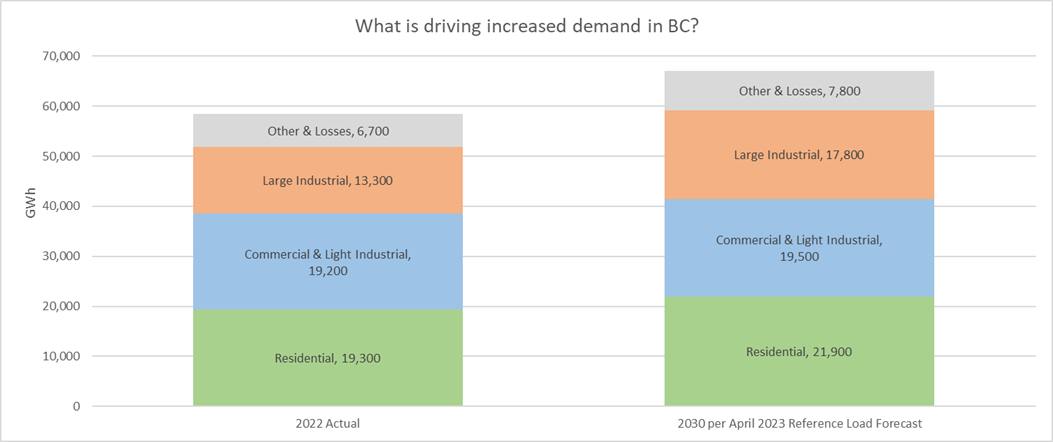
Note: Estimated demand for electric vehicles in 2030 is 1,300 GWh, or only 2% of total energy demand, which is included in the residential and commercial forecast
Source: BC Hydro
BC Hydro's plan to meet future demand
BC Hydro’s updated Integrated Resource Plan (IRP) outlines how BC Hydro will meet the electricity needs of its customers over the next 20 years and reflects BC’s legislated greenhouse gas reduction targets and electrification. It’s a flexible plan that allows BC Hydro to monitor changing conditions and adjust its planning to meet the future needs of customers.
In addition to Site C coming online and BC Hydro’s first competitive call for power in 15 years, the IRP includes a range of actions to meet future demand, including:
- Ramping up demand-side management (including energy efficiency) activities and investments to conserve energy and limit peak demand to achieve greater customer energy savings
- Offering optional rates, like the new voluntary Time-of-Day rate, to achieve system capacity savings, including for home charging of electric vehicles
- Renewing electricity purchase agreements with existing clean or renewable independent power producers on a cost-effective basis
- Advancing upgrades to transmission infrastructure to achieve additional capacity
- Advancing the integration of utility-scale batteries (energy-storage systems)
The BCUC approved BC Hydro’s IRP in March 2024, following a multi-year regulatory proceeding that included participation from 36 stakeholder intervenors and BC Hydro answering approximately 5,000 questions. This is the first time since 2006 that the BCUC has had the opportunity to provide valuable oversight and approval of BC Hydro’s IRP. The BCUC’s oversight of long-term energy planning was restored in 2019 through legislative amendments to the Utilities Commission Act.
In the current context of increasing change, the BCUC accepted BC Hydro’s proposal to develop more frequent and targeted updates to its IRP – to ensure it is making adjustments based on shifts in BC’s economy and energy system – with its next IRP to be filed in Fall 2025.
Planning for an increasingly electrified future
The latest research from public and private organizations suggests that BC's electricity use will likely double from current levels in order to keep up with population and economic growth, transition from fossil fuels, and achieve net zero emissions by 2050. The Canadian Climate Institute, for example, estimates that BC will need to add 1.3-2.6 times more generation and 1.8-2.9 times more capacity by 2050. With this level of use, electricity would become BC’s largest source of energy (at 17%, electricity is currently the third largest source, after refined petroleum products and natural gas).
While 2050 is more than two decades away, BC must and is beginning to plan today for a future where electricity use doubles by 2050 and overtakes fossil fuels as the largest energy source in the province. That’s why this year’s call for power is just the beginning. BC Hydro will proceed with issuing regular calls for power every two years so that we are continuously increasing and diversifying BC’s electricity production as the economy grows and the transition to clean energy keeps accelerating. The exact volume (energy and/or capacity) of future calls and timing of acquisitions will continue to be determined through BC Hydro’s long-term resource-planning process, under the oversight of the BCUC.
Committing to regular calls for power sends a strong and necessary signal to the renewable power sector to invest and advance utility-scale clean electricity projects in BC. It also provides certainty to industries of all types that BC will have the power needed for major projects, such as new critical minerals mines and hydrogen production facilities. And by aiming to expand production continuously in line with future demand, we can also keep costs down for current BC Hydro customers.
Distributed self generation and storage
The energy system of the future will also be increasingly decentralized and distributed. In addition to large generation and transmission infrastructure across the province, this means more opportunities for participation by communities in small-scale energy production and storage to meet local needs. That’s why BC Hydro is launching an enhanced Self-Generation Program (also called “net metering”).
For the first time, customers can receive rebates to install solar panels and generate their own clean electricity, reducing the amount of electricity that BC Hydro needs to supply. Customers can export back to the grid and receive bill credits for any excess electricity they self-generate. Rebates will be available for battery storage systems that will enable the use of solar energy as a flexible resource to address local capacity constraints, which can avoid most costly system upgrades.
BC Hydro will also be proposing changes to the BCUC to increase the size of self-generation projects able to participate in the program, enable community net metering so that multiple customers can contribute to – and benefit from – the same generation project, and ensure the amount customers are paid for excess electricity reflects its value to the system.
Maximizing our production of clean fuels
Not all energy needs can be met through electricity and utility-scale batteries. Liquid and gas fuels will remain essential for the foreseeable future, especially in areas like long-haul transportation, certain industrial processes, and in remote communities not connected to the electricity grid. BC’s gas system will also continue to play an important role for many years to come in order to maintain system resiliency, meet peak energy demand, and provide home heating in colder climates. And when it comes to transportation fuel, we are still largely dependent on imports from other jurisdictions, with the exception of Burnaby’s Parkland Refinery and Prince George’s Tidewater Renewable facility, both of which are leaders in producing renewable and low-carbon fuels.
BC is a North American leader with a robust set of policies to encourage the production and use of clean fuels, including the Low Carbon Fuel Standard and Greenhouse Gas Reduction Regulation. Producing more clean fuels like hydrogen, renewable natural gas, and biofuels right here in BC helps us replace fossil fuels with clean energy and make BC more energy independent. These policies also help drive new investment and create good jobs for people. This will be government’s priority moving forward, with BC's new Clean Energy & Major Projects Office (CEMPO) helping to fast-track investment in clean energy and create good, sustainable jobs in the transition to a clean economy. First announced in March 2023 and now fully operational, CEMPO is already providing dedicated, cross-government support to advancing major energy projects with a focus on clean fuels.
Maintaining BC’s existing gas infrastructure is necessary to ensure BC can deliver clean fuels as production ramps up in the years ahead, in addition to supporting the resiliency of BC’s energy system.
Hydrogen
As the first Canadian province to design and implement a hydrogen strategy, BC is committed to growing its hydrogen economy. We are well positioned to do so, with our abundant natural resources, renewable electrical grid, and long history of innovation in hydrogen and fuel cell technology. For decades we have been creating the environment and making the investments necessary to attract researchers, entrepreneurs, innovative companies, and investors to BC’s hydrogen ecosystem.
Since the release of the Hydrogen strategy Government has been taking action to advance the production, distribution, and use of low carbon hydrogen by working with partners to create regional hydrogen hubs where production and demand are co-located to lower costs and maximize benefits for local economies.
More than 50% of Canada’s hydrogen and fuel-cell companies are in BC, and the province accounts for about 60% of research investment in hydrogen and fuel-cell technology.
The province also offers significant opportunities to produce low-carbon hydrogen for local use and export, thanks to our low-cost, clean, and renewable power, vast natural gas reserves, and carbon sequestration potential.
BC is working to create conditions to support a growing hydrogen sector, from supportive provincial policies, significant government investments toward innovation, proximity and strong trading relationships with key export markets and a stable investment climate.
The $900 million H2 Gateway project is aimed at reducing emissions in the transportation sector. HTEC plans to build and operate an interprovincial network of as many as 20 hydrogen refuelling stations (with 18 in BC) to support the deployment of heavy-duty fuel cell trucks and advance greener transportation solutions. The refuelling stations will be supported by three new electrolyzers in Burnaby, Nanaimo and Prince George, and a new facility that liquefies 15 tonnes per day of byproduct hydrogen in North Vancouver. The H2 Gateway projects are estimated to create more than 280 full-time jobs to build, operate and support the hydrogen infrastructure. H2 Gateway will also support the development of regional hydrogen hubs across the province where production and use are co-located to lower costs and maximize benefits for local economies.
Renewable natural gas
Renewable natural gas is methane that comes from biological sources, which could include landfills, sewage and food, agricultural or forestry waste. Natural gas and renewable natural gas are practically chemically identical; they can be mixed, processed, stored, transported and used the same way. Renewable and low carbon gases will enable households and businesses to lower emissions while ensuring the province’s energy system is reliable, especially for peak demands brought on by cold weather.
FortisBC is working to ramp up production of Renewable Natural Gas (RNG), with 8 suppliers online from BC as of May 2024.
The Capital Regional District will contract Waga Energy, through its subsidiary Hartland Renewable Resource Group, to design, build and operate a new district facility that will upgrade the biogas generated at Hartland Landfill to Renewable Natural Gas (RNG). The renewable natural gas that will be produced at Hartland Landfill is a carbon-neutral energy made from capturing and upgrading the biogas released from decomposing organic waste in the landfill. This project is expected to reduce the region’s greenhouse gas emissions by approximately 450,000 tonnes over the next 25 years. FortisBC will purchase the renewable natural gas to be blended into the region’s existing natural gas infrastructure to help decarbonize our natural gas supply.
Biofuels
The CleanBC Roadmap to 2030 includes a target for BC to produce 1.3 billion litres of renewable fuel by 2030. The shift is supported by BC’s Low Carbon Fuel Standard (LCFS), which requires fuel suppliers to make their products progressively less carbon intensive. First implemented in 2010, the LCFS is among BC’s most successful and cost-effective emission reduction policies – between 2010 and 2022, it avoided 18.8 million tonnes of emissions. It is also attracting investment to BC and creating new, good jobs for people in the clean economy. Agreements are now in place under the Low Carbon Fuel Standard for 42 projects that represent investments expected to exceed $2.25 billion. And we are on track to produce about 840 million litres per year already by 2026. To ensure we build on this progress and remain a leader in renewable fuel production, BC is increasing its target to 1.5 billion litres produced per year by 2030.
BC is also setting the pace to develop sustainable aviation fuel and reduce emissions from air travel. In January 2024, the LCFS was expanded to include jet fuel and its alternatives. The new regulations now set low-carbon and renewable fuel content requirements for jet fuel in BC and require a 10% reduction in the carbon intensity of jet fuel by 2030. Canadian production capacity for sustainable aviation fuel is projected to grow significantly to be nearly 900 million litres per year in 2027, rising to nearly 2 billion litres per year by 2030.
Partnership with Lheidli T’enneh First Nation to expand domestic biofuel production
Supported through the Low Carbon Fuel Standard Initiative Agreement, Arbios Biotech Canada Limited is working with the Lheidli T’enneh First Nation to construct and operate a biomass-to-liquids facility in Prince George. The facility will convert 25,000 dry tons of residue wood biomass to 50,000 barrels of sustainable bio-oil per year. When in full capacity the facility is expected to employ approximately 50 people, with skills ranging from engineers to process operators to management.
Partnership with Vancouver International Airport to accelerate sustainable aviation fuel solutions
Vancouver International Airport (YVR) is Canada’s second-largest international airport, having welcomed nearly 25 million passengers in 2023. It is also one of the Province’s biggest employers and economic drivers of growth and revenue. Through a signed memorandum of understanding (MOU) in March 2024, YVR and the Province will collaborate with Indigenous partners, communities and aviation and aerospace stakeholders over three years to accelerate sustainable aviation to fight pollution and reduce emissions. The MOU will also increase clean-tech investments to promote made-in-BC technology and good jobs.
To kick off this new partnership with YVR, the Province is investing in three key projects that will support the broader aviation industry. One of these projects is a $250,000 investment from the Province for a sustainable aviation fuel opportunities study to accelerate the development of new technologies and opportunities in this sector. The MOU will also help enhance access to reliable, sustainable air services – a vital element for Indigenous and rural communities as it ensures access to critical health and emergency services, supports job creation, creates business and tourism opportunities, and maintains connections to other parts of the province.
Building out BC’s electricity grid and connecting customers faster
Not only will BC need to produce more electricity in the years to come, we must also strengthen the transmission and distribution system to safely and reliably deliver that energy to the homes, businesses and industries that need it.
In January 2024, BC Hydro announced its plans for an unprecedented level of construction over the next decade, building out our electricity grid to power a growing clean economy and communities, and create new jobs. BC Hydro’s updated 10-Year Capital Plan (2024/25 to 2033/34) includes almost $36 billion in community and regional infrastructure investments across the province, an increase of 50% over its previous capital plan.
This includes:
- $21 billion to ensure existing assets can handle the expansion and continue to serve future generations. This includes replacing aging power poles and lines, upgrading transformers and substations, as well as making critical investments to ensure the safety of dams and reservoirs.
- Almost $10 billion for new electrification and emissions reduction efforts, including reducing the use of diesel generators in remote communities, major transmission infrastructure like the North Coast Transmission Line, and investment in seven new substations. These investments support increasing electrification of homes, businesses, transportation, and industries.
- More than $5 billion to support new customer connections, particularly in high growth communities across the Lower Mainland and Vancouver Island.
BC Hydro’s 10-Year Capital Plan will increase and maintain BC Hydro’s capital investments as major projects like Site C are completed.
Streamlining customer connections
Every year, BC Hydro completes approximately 35,000 customer upgrades and new connections on its distribution system. In the past four years, customer connection requests have increased by 36% and are expected to continue to increase. Following on the recommendations of the BC Hydro Task Force, BC Hydro is taking actions to streamline and accelerate distribution customer connections, with a focus on speeding up the completion of new housing development in growing communities.
Last updated in 2008, BC Hydro’s Distribution Extension Policy sets out how costs are allocated between new and existing customers for connections to the BC Hydro grid. In recent years, municipalities, home builders and other stakeholders have been advocating for changes to improve cost equity and predictability under the policy, especially where a new or upgraded connection requires system upgrades that currently must be completely borne upfront by the initial customer that makes the request.
BC Hydro is moving forward with a BCUC application to update its Distribution Extension Policy to eliminate system improvement costs for all new customers (except in extraordinary circumstances) and to increase BC Hydro’s maximum contribution to offsetting extension costs. These updates will provide greater cost certainty for customers and help to support investments in affordable housing (including larger multi-unit developments) and in electrification by homes and businesses.
Making EV charging more accessible
Making the switch to an electric vehicle means less pollution, cleaner and healthy communities, and savings on fuel costs. British Columbians want to have confidence that they will be able to charge up easily when travelling across the province. That’s why government is working with BC Hydro, FortisBC, municipalities, and other partners to expand BC’s public charging infrastructure.
BC already has one of the largest growing EV public charging infrastructure networks in Canada. As of April 2024, there were more than 5,000 public charging stations in BC, an increase from approximately 1,500 stations in 2018. And we are on track to complete BC's Electric Highway in Summer 2024, achieving coverage along all highways and major roads.
The CleanBC Roadmap to 2030 included an overall target of BC having 10,000 public charging stations by 2030. With EV sales increasing faster than anyone could have predicted when the Zero Emission Vehicles Act was passed in 2019 and already representing almost one out of every four light-duty cars sold in the province, government is currently revising BC’s 2030 target for public charging stations. And, to ensure that every community in BC has access to a fast-charging station, Budget 2024 included an additional $30 million to add more than 500 public fast chargers, with priority being placed on applications for locations highly accessible to the public, including community and recreation centres, libraries, highway rest stops and park-and-ride stations.
Expanding opportunities for Indigenous Peoples
First Nations have long been leaders in the clean energy sector, developing projects that further their energy independence, create new economic opportunities, and/or power their communities with clean energy. Consistent with the Province’s commitments to reconciliation, advancing meaningful partnerships with First Nations is critical to achieving the goals of Powering our Future – partnerships that enable Indigenous-led clean energy projects as well as benefit from other clean energy projects being developed in their territories.
That’s why BC Hydro engaged extensively with First Nations on the design of its recent call for power, including close collaboration with the First Nations Energy and Mining Council. And similar to recent calls for clean power by other jurisdictions – including Alberta and Saskatchewan – projects must have a minimum percentage of equity ownership held by First Nations. To enable this participation, the Canada Infrastructure Bank will make loans available as an option for First Nations to help finance as much as 90% of their equity position in a project that is awarded an electricity purchase agreement under the call for power. Looking to the future, government will engage with First Nations on their experiences with BC Hydro’s first call for power to identify lessons learned and explore options to further support Indigenous participation in future calls for power.
Government is exploring options to advance co-ownership opportunities with First Nations in new, major transmission lines crossing their territories, beginning with the North Coast Transmission Line. In Ontario, for example, Hydro One offers First Nations a 50% equity stake in all-new, future transmission line projects above a certain size. Co-ownership opportunities not only ensure First Nations can participate in and benefit from new infrastructure being build on their territories, but also can help to streamline consultation and permitting processes to accelerate the construction of significant electrification projects.
Supporting smaller community-scale projects
While BC Hydro’s 2024 call for power is targeted to larger, utility-scale projects (40 MW – 200 MW) to capture economies of scale, there are still many grid-connected First Nations across the province interested in building smaller, community-scale projects. That’s why Government recently provided a $140 million endowment to the British Columbia Indigenous Clean Energy Initiative (BCICEI), a clean-energy funding partnership between the Province of British Columbia, the Government of Canada and the New Relationship Trust. BCICEI is currently engaging with First Nations on the design of a new funding stream to support smaller, Indigenous-led clean energy projects to help offset their higher costs relative to larger, utility-scale projects. Interest from the endowment (approximately $6.5 million per year) is being used to support BCICEI’s existing funding streams to advance projects to the construction stage.
Supporting remote communities to get off diesel
British Columbia has approximately 40 remote communities that are not connected to the electricity grid, most of which are First Nations communities. Many of these remote communities are served by BC Hydro, while some own and operate their own diesel generators. Each year, these remote communities consume around 19 million litres of diesel, one of the most expensive and polluting fuels available. An initiative of CleanBC, the Community Energy Diesel Reduction Program (CEDR) aims to reduce diesel use in remote communities by 80% by 2030, helping to reduce pollution, support energy independence, and build healthier, more resilient communities.
A recent example of the move away from diesel dependence is the Ulkatcho First Nation’s new solar energy project. The $30-million project — which is receiving $16 million in provincial and federal funding — is expected to produce enough electricity to power about 350 of the area's 5,000 homes, according to BC Hydro. This project is set to reduce the need for diesel generation in this remote community by about 64% – equal to a reduction of 1.1 million litres of diesel per year – and will be the largest off-grid solar project in Canada. Located in Anahim Lake in Central BC, the Ulkatcho First Nation’s power is currently 100% diesel generated. BC Hydro will buy the solar energy through a Community Electricity Purchase Agreement and integrate the energy into its microgrid through a line interconnection and battery energy storage system to then serve the community.
Indigenous Clean Energy Opportunities (ICEO) Initiative
Launched in 2021, the Indigenous Clean Energy Opportunities (ICEO) Initiative is a collaboration between the First Nations Leadership Council, the First Nations Energy and Mining Council (FNEMC), and the Ministry of Energy, Mines and Low Carbon Innovation. Through the ICEO process, FNEMC and the Ministry seek to engage First Nations rights holders and organizations in a collaborative dialogue to position First Nations to fully participate in current and future opportunities in British Columbia’s clean energy sector and align the Province’s strategic clean energy policy and legislation with the United Nations Declaration on the Rights of Indigenous Peoples.
A key topic of focus for the 2024/2025 ICEO workplan is to identify what obstacles are being faced by First Nations interested in entering or enhancing their participation in BC’s clean energy sector, and what new supports and programs could address these capacity gaps, including consideration of a new Indigenous-led, province-wide organization.
Planning for a resilient future
Part of what makes BC’s energy system resilient is the diversity of its energy sources. For example, a record-breaking cold snap in January 2024 drove BC’s hourly peak demand to new highs. BC Hydro was able not only to meet that peak demand at home in BC, but also to export much-needed power to our neighbours in Alberta. Natural gas was also critical in meeting peak demand, delivering about twice as much energy for home heating as the electricity system during this time – highlighting the importance of BC’s existing gas system.
Integrated utility planning
Electricity and gas can be complementary energy sources, for example where the gas system’s role in heating acts as a back-up for clean electricity, but currently their futures are planned independently through separate resource planning processes. Coordinated planning of electric power and gas systems is critical to optimize investments, reduce emissions, and keep energy affordable as BC’s energy mix changes in the coming years and decades. As part of the work to develop Powering Our Future, the Government, BC Hydro, FortisBC and Pacific Northern Gas (PNG) agreed on the need to advance joint planning in the future to help keep our energy system affordable, reliable and efficient in the transition to clean energy and a net zero economy.
Specifically, planning together will enable:
- More efficient use of energy resources, with electricity and gas each used where and when they make the most sense (for example, based on climate regions),
- Understanding how clean electricity and a decarbonized gas system can work together in the future, with a focus on meeting peak demand while cost-effectively reducing emissions, and
- Better coordination among our electric and gas utilities to limit unnecessary and costly infrastructure investments.
While fully integrated utility planning through the BCUC will take time to implement, government will continue to advance joint planning between the electric and gas utilities.
Exploring pathways to net zero emissions by 2050
As a key next step in the energy transition, BC will undertake an independent net zero pathway assessment – a comprehensive study of all the credible pathways for achieving a net zero economy by 2050. Other jurisdictions, such as Ontario and Quebec, are increasingly turning to “pathway assessments” to develop a shared understanding of the different approaches available to achieve net zero emissions. This includes evaluating specific choices and trade-offs, identifying options, and bringing people together for an evidence-based discussion about the province’s energy future.
A key focus of BC’s net zero pathway assessment will be the impacts of electrification of home heating on electricity and natural gas planning and identifying the role of a decarbonized gas system – with increasing amounts of renewable natural gas and hydrogen – in BC’s future energy system. For example, in colder climates, dual fuel systems may make the most sense where low-carbon gases serve as back-up during colder temperatures where electric heat pumps are less efficient and the electricity system is unable to meet peak demand annually.
Creating jobs and supporting sustainable growth
Powering our future with clean energy is one of the job-creation opportunities for our generation. BC Hydro’s capital plan and its first call for power are estimated to lead to total public and private capital investments of approximately $40 billion and create between 11,300 and 14,000 construction jobs annually.
|
Initiative |
Type |
Capital Investment |
Job estimates (construction) |
|---|---|---|---|
|
BC Hydro 10 Year Capital Plan |
Public |
$36 billion |
10,500 to 12,500 jobs on average annually (over 10 years) |
|
BC Hydro’s 2024 call for power (first in regular calls every two years) |
Private |
$2.3 to $3.6 billion* |
800 to 1,500 jobs on average annually |
* Does not include additional investment to connect new power projects to the grid
The shift to clean energy will also create jobs in new emerging professions like heat pump installation, rooftop solar installation, efficiency retrofits, electric vehicle charging and maintenance. For example, by accelerating efficiency retrofits, the CleanBC Better Homes and Better Buildings program has created approximately 800 jobs per year.
To ensure people and employers are prepared for these and other opportunities, the Province is investing nearly half a billion dollars in the StrongerBC Future Ready Action Plan, connecting people to the training they need for more than 250 in-demand careers in areas such as construction, technology, clean energy and housing. For BC employers, many of whom are facing a shortage of skilled workers, the plan means approximately 8,500 newly-trained people will be ready to fill positions in the next three years.
Training people for the clean energy skills of the future
Electric vehicle technicians training
As zero-emission cars gain in popularity, there is a growing need for technicians and mechanics who can service these vehicles. The Province provided $325,000 in funding to the British Columbia Institute of Technology to develop a first-of its-kind training course for certified Red Seal automotive service technicians to upgrade their skills for zero-emission vehicles. The curriculum was designed in partnership with the City of Vancouver’s green-fleet technicians and includes course modules for servicing battery electric, plug-in hybrid and fuel cell electric vehicles.
Heat pump installation
Continued growth in the popularity of heat pumps will require a significant expansion of qualified heat pumps installers in BC. The Province has been working with utilities and the heating, ventilation and air conditioning industry to develop best practices training for heat pumps. The Province’s work also includes consideration of trades qualifications to ensure there are viable options for transitioning members of other trades like gas-fitters.
Hydrogen
Innovation in the hydrogen sector is supported by cutting-edge research conducted at BC’s universities and technical institutes, which are also training the next generation of talent working in this field. Since 1994, the Institute of Integrated Energy Systems in the University of Victoria has been working on feasible pathways to sustainable energy systems by developing technology and training for the next generation of changemakers. The Institute formed Canada’s first major university-industry research partnership focused on fuel cells and hydrogen systems and continues to be an active research centre in fuel cell modelling, hybrid power trains and hydrogen storage.
BC’s clean and competitive advantage
Clean, affordable electricity helps to attract investments in new businesses like E-One Moli. In 2023, the company announced plans to build a $1.05 billion lithium-ion battery manufacturing plant in Maple Ridge, in part based on the ability to power their operations with affordable clean electricity. The plant will be Western Canada’s first high-performance lithium-ion battery plant and provide around 450 good jobs.
Businesses increasingly want to locate and invest in jurisdictions that can guarantee their energy needs are not contributing to climate change. That’s why BC recently updated the energy objectives in the Clean Energy Act, amending the existing objective that 93% of the electricity generated in BC needs to come from clean or renewable electricity generation (which the Province has surpassed) to a target of 100% by 2030 for the integrated grid. While this will not affect remote communities or the use of gas-fired electricity generation as emergency back-up, or the use of natural gas for other needs such as home heating, it will ensure that BC capitalizes on its clean advantage when competing with other jurisdictions for investment.
The clean electricity we use in BC also makes our products cleaner and more attractive to investors and customers. In the critical minerals sector, clean electricity enables BC to better contribute to the global transition to a low carbon economy and power BC mines, which are producing critical minerals used to produce electric vehicles, renewable energy systems and energy storage devices. Clean electricity provides a competitive advantage for our mines and supports growing this sector while making progress on reducing emissions. For example, mining one tonne of copper in BC produces over 20% less GHG emissions than one tonne mined in Chile, primarily due to our clean power supply.
Electrifying mining trucks at Copper Mountain
By working with industrial partners, the province is leading the way in the electrification of mining operations. One example of this partnership at work is the Province’s $10 million contribution toward the installation of an electric trolley system for mine-haul trucks at Copper Mountain Mining Corporation’s copper, gold and silver mine near Princeton, BC. This funding, provided through the CleanBC Industry Fund, supported upgrades to seven of the company’s trucks to be compatible with an overhead trolley system that replaces diesel used by the haul trucks to transport mine material to a surface processing facility with clean electricity, significantly reducing emissions.
The Copper Mountain project is the first trolley assist to be installed in an open-pit mine in North America. Learnings from this project will help refine the technology to drive wider adoption of similar solutions across the industry.
Enabling industrial development
Growing our industrial base is critical to our economic future, providing jobs and contributing to growth. BC is seeing unprecedented interest from new, major industrial customers developing new or expanded projects in BC and wanting to power their operations with clean electricity. There are currently approximately 7,000 Megawatts (MW) of proposed new industrial demand in BC Hydro’s interconnections queue. For comparison, the current BC Hydro system demand in 2024 is about 11,000 MW and the total capacity of Site C will be about 1,100 MW.
This unprecedented interest encompasses everything from traditional natural resource industries, such as mining and oil and gas, to newer industries like green hydrogen production and advanced manufacturing. While we know from past experience that not all projects that enter BC Hydro’s interconnections process end up proceeding, this is an enviable position for any province to be in and shows that BC is poised for clean industrial growth over the next decade.
Proponents of projects that require extremely large amounts of power (e.g., above 150 MW) require certainty that the electricity will be there when they need it, while BC Hydro requires assurance that projects will proceed prior to constructing expensive new infrastructure. BC Hydro’s current tariff for connecting large industrial customers was developed almost three decades ago, receiving approval from the BCUC in 1991. New models are needed.
Government will develop and engage with industry on innovative approaches for connecting new, large industrial customers that provide greater certainty on timelines and other requirements, prioritize projects that create jobs and benefit British Columbians, and protect existing BC Hydro customers from rate increases. For example, this may include changes to pool customer contributions for new transmission lines across multiple customers and looking at project-specific calls for power for customers that require significant new generation capacity.
Figure 6: Cumulative volume added to BC Hydro’s interconnection queue by year
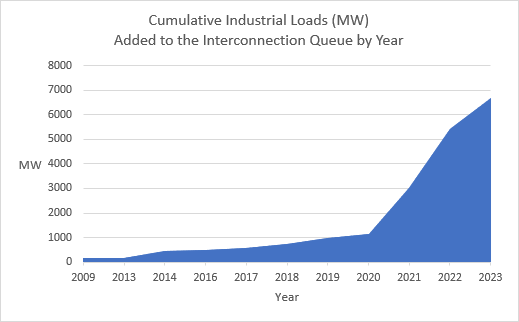
Source: BC Hydro
Driving innovation and clean energy technology
Energy systems are constantly changing in response to advances in technology – from LED light-bulbs to cold-climate heat pumps and electric vehicle batteries – that enable new clean energy solutions while lowering costs. Powering Our Future recognizes that BC must remain an innovation leader to achieve our energy goals. This means not only accelerating the integration of commercially proven technologies into the system, but also supporting the development of new technology that will change what is possible in the years to come.
The Innovative Clean Energy (ICE) Fund supports cutting-edge partnerships with universities, First Nations, municipalities, and clean tech companies across BC. Since its inception in 2008, it has committed over $112 million in funding to help advance technologies that harness the potential of a range of clean energy options including solar, ocean tidal, geo-exchange, energy management, smart grid and waste-to-energy approaches. In May 2024 the fund launched a new targeted call for over $12 million in new projects over the next three years, with a focus on clean energy optimization and management technologies.
FortisBC’s Clean Growth Innovation Fund will help the utility invest in innovative, emissions-reducing projects in partnership with government and industry, with a focus on renewable natural gas, carbon and methane capture, energy efficiency, and fuel cell and remote power technologies.
BC Hydro recently announced Canada's first “vehicle-to-grid” pilot project for medium- and heavy-duty vehicles – allowing them to push energy from their batteries back into the grid. The bidirectional charging trial project for medium-sized vehicles such as buses, and heavy-duty vehicles like transport trucks, is the first of its kind in Canada. While this is an emerging technology, it could have the potential to displace diesel back-up generation in the future as a clean power source.
Accelerating utility-scale batteries
Utility-scale batteries are a relatively new technology within the traditional utility sector. The costs of battery storage technology have decreased in recent years and utility-scale batteries can open up new opportunities for managing the electricity grid by shifting output from renewables – such as solar panels – into periods when demand is higher and it is needed most.
As part of its Integrated Resource Plan, BC Hydro is accelerating its work to explore and advance integration of utility-scale batteries into the grid with the aim of achieving up to 600 MW of additional capacity by 2030.
B.C. Centre for Innovation and Clean Energy
Founded in 2021 with an initial $35 million provincial investment leveraging an additional $70 million from federal and private sources, the B.C. Centre for Innovation and Clean Energy is an independent, not-for-profit corporation that helps fund the commercial development and scaling of made-in-BC clean energy solutions — from Canada to the world. The Centre brings together innovators, industry, governments and academics to accelerate clean energy innovation and catalyze new partnerships.
The Centre’s focus areas for funding and project delivery currently include:
- Carbon management
- Production, use and distribution of low-carbon hydrogen
- Low carbon fuels including renewable natural gas, biofuels and synthetic fuels
- Battery technology, storage and energy management system
Trading with our neighbours to benefit BC
All utilities across jurisdictions, including in BC, are importing and/or exporting power every hour of the year. This is key to the reliable operation of the Western Interconnection – a network of transmission lines connecting BC with utilities in Alberta and 14 western U.S. states. BC Hydro’s trading subsidiary Powerex, imports and exports power to help BC Hydro manage its system, keep rates low for British Columbians, and help reduce emissions in other jurisdictions still reliant on coal or natural gas for baseload electricity generation.
Importing can be a very cost-effective way to buy surplus electricity from another jurisdiction that would otherwise go to waste, such as wind and solar that cannot be stored. Imports of electricity also allow BC Hydro to conserve and store water in its reservoirs – which act like large batteries, reserving generation for periods when it is needed most in BC or has the highest value on the export market.
British Columbians have access to the cleanest electricity in western North America and BC is well-positioned to benefit from electricity trade as a result of our flexible system of hydro-electric storage reservoirs. Increasing amounts of renewable generation, such as solar and wind, are being added to the western grid as other jurisdictions get off of coal- and natural gas-fired electricity. When electricity generation is abundant, and prices tend to be lower, BC Hydro can decrease its generation and Powerex, a subsidiary of BC Hydro, can import electricity during these times. At other times prices might be higher such that BC Hydro can generate more than it needs domestically and Powerex can export the electricity to other jurisdictions. Powerex’s import and export activity helps reduce emissions in the electricity sector, while also creating trade income that keeps BC Hydro’s rates amongst the lowest in North America.
Powerex’s trading activities result in significant revenue that is passed onto BC Hydro to keep rates lower for its customers. In total, Powerex’s trade income over the last five fiscal years was $2.485 billion.
Figure 7: Illustrative example of how market prices can fluctuate over the day
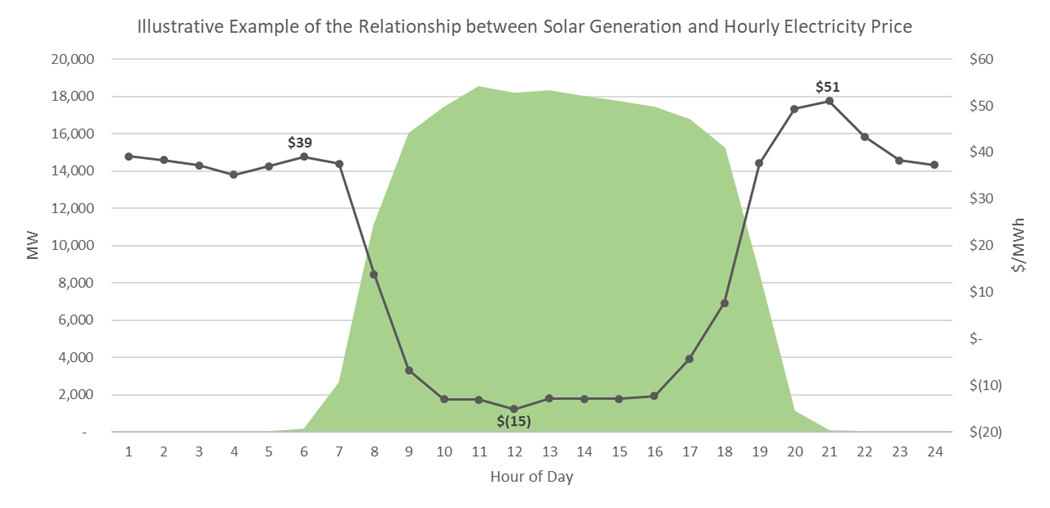
Note: Information provided in the graph is for illustrative purposes only and may not represent current or future conditions; information from May 9, 2024
Source: CAISO solar generation and SP-15 (Southern California) day-ahead hourly prices
Planning for self-sufficiency
While BC Hydro plans for a balanced system, there is a great deal of weather variability that can affect both generation and demand, with some years being wetter or drier, some colder or warmer. Under the Clean Energy Act, BC Hydro is required to be self-sufficient based on average water years. This means that in some years BC will be in surplus (and a net exporter), while during others it will be in deficit (and a net importer), like during 2023 due to the current drought.
In fact, over the last 15 years, BC was a net importer in seven years and a net exporter in eight. And even with the historic drought that has significantly impacted our water reservoirs, BC was still a net exporter over the last five-year period.
In its next Integrated Resource Plan, BC Hydro will be reviewing the latest research on climate change scenarios and examining how it may impact reservoir levels in the decades to come – and if that means more generation capacity is needed. In addition, by bringing more renewables onto the grid like wind and solar, B.C will diversify how it generates electricity and make us more resilient in face of more frequent and extreme droughts.
Importing clean power
Electricity imported into BC by Powerex is from two sources. First, from identifiable clean resources like hydro and other renewable facilities. Over the past five years, the majority of its imports were from dedicated clean sources of electricity like these.
Second, from the wholesale market, which is a mix of all resources on the grid in other jurisdictions. Market electricity in the west continues to trend away from fossil fuels toward cleaner forms of generation, as more wind and solar replace retiring coal and natural gas. In recent years, more renewables, like solar, have created periods of short-term over-supply in places like California where solar generation is highest during mid-day. This is the time of day when Powerex generally imports given that prices are lower.
The greenhouse gas intensity of the electricity used by BC customers on the integrated grid is determined by the Province’s Climate Action Secretariat. The Electricity Emissions Intensity Factor, which incorporates data on Powerex’s imports and exports was reported at 11.3 tonnes of CO2 equivalent per GWh in 2023. For comparison purposes, the emissions rate from gas or coal generation is approximately 500 or 1,000 tonnes of CO2 equivalent per GWh, respectively.
Advocating for fair access to Alberta’s markets
Although 90% of Powerex’s trading activity is with the Western US, it also trades with Alberta through the BC-Alberta intertie.
In March 2023, the Alberta Electric System Operator (AESO) chose to unilaterally reduce the import capacity of the Intertie. This restricts BC from selling clean electricity to Alberta customers despite the fact that BC provides non-discriminatory access along the intertie that allows Alberta to export gas-fired electricity through BC to the U.S.
Intertie access is intended to be reciprocal, and BC will continue to advocate for Alberta to lift these restrictions, like they did during the recent January cold snap and emergency grid alert in Alberta, enabling BC to provide nearly 300 MW of clean electricity during Alberta's time of need. Although it may limit competition for natural gas-fired generators in Alberta, delaying full restoration of the Intertie undermines the value of having an interconnected grid and ultimately increases electricity rates for both British Columbians and Albertans.
Conclusion
British Columbia is well positioned to power our clean energy future, and to ensure everyone has the opportunity to benefit as we make the transition away from fossil fuels. Our legacy system of clean hydro-electricity provides the backbone for a broader clean energy system, with more renewables like wind and solar and more clean fuels like hydrogen, renewable natural gas, and biofuels.
We are building a future where no one is left behind, where innovation drives progress and keeps our economy competitive to improve our quality of life. Indigenous Peoples will have opportunities to advance self-determination and be leaders in building the clean economy. And everyone in British Columbia will have the opportunity for a cleaner, more secure and better future.
To advance this strategy, we will engage with key stakeholders and Indigenous Peoples on implementation by identifying the priority objectives, actions and timelines that will ensure BC accelerates its production of affordable and reliable clean energy to support the Province’s CleanBC, economic development and affordability goals.

